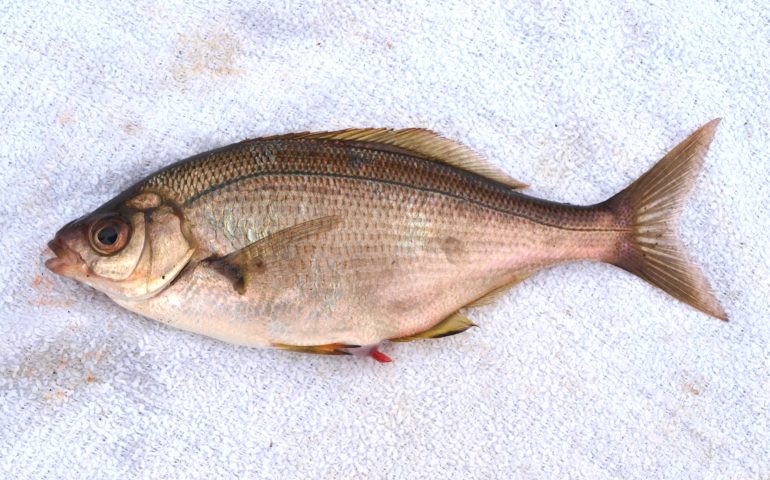Surfperches: Family Embiotocidae
Species: Phanerodon atripes (Jordan & Gilbert, 1880); from the Greek root words phaneros (meaning evident) and odons (tooth) and the Latin words atri (entrance) and pes (base of). Family Embiotocidae, subfamily Embiotocinae.
Alternate Names: Blackfoot seaperch and sharpnose surfperch. In Mexico called mojarra picuda.
Identification: These surfperch are very similar in shape to the white seaperch but coloring is different and the pelvic fins are black tipped. Their coloring is silvery with reddish-brown marks on the back, and dusky pelvic fins.
Size: To 11.5 inches but most caught off piers are between 8-10 inches.
Range: Islas San Benito, central Baja California, to Yaquina Bay, Oregon. Common from Punta Baja, northern Baja California, to central California.
Habitat: Shallow to deep water and around kelp beds.
Piers: This is a perch that is often found in deep water—down to 750 feet deep. However, during summer months it moves into shallower waters to spawn. During those months it is an infrequent catch at several Monterey Bay piers. Best bets are Monterey Wharf #2, Monterey Coast Guard Pier, Seacliff State Beach Pier, Capitola Wharf, and the Santa Cruz Wharf.
Shoreline: An occasional catch by shore anglers in central California.
Boats: An inshore species rarely taken from boats.
Bait and Tackle: By far, the best bait is live pile worms or small crabs; next would be fresh mussels or small pieces of shrimp. The most common setup used by locals in Monterey is a small size 8 hook fished directly on the end of the line with a small split-shot sinker attached a short way up from the hook. Above this is attached a small bobber which indicates when the fish bites; anglers here seem to give a quick jerk to try to hook the light-biting fish. The fish are generally found in the surface canopy or mid-depth area, which is one reason for using the bobber. The ones I have caught were all taken on a high/low leader.
Food Value: Most are fairly small yielding little meat. The flesh is mild in flavor with small flakes and soft texture. They taste best during the non-spawning season, are low in fat content, and can be cooked using most methods.
Comments: This seems to be one of the harder perch to hook. I spent several exasperating hours fishing for these perch at the Monterey Wharf #2 and watching locals (a few with the know-how) catch them before I caught my first sharpnose seaperch. However, since then I’ve caught several of the fish at the pier using my normal high/low leader and adjusting the depth of the line to where I was getting bites.
For whatever reason, there has seemed to be considerable fluctuations in the population of these fish over the years—or at least in the reported population. Jordan and Gilbert (1882) said “Monterey Bay, locally abundant,” while Eigenmann (1893) said “the commonest species in Monterey Bay.” However few sharpnose were reported in Fish and Game surveys over the years until the 1960s when they again began to show up in decent numbers.
It’s reported that sharpnose seaperch act as “cleaner fish” during the fall when Mola mola, the ocean sunfish, come in to the shallow waters at Point Lobos just south of Monterey.
